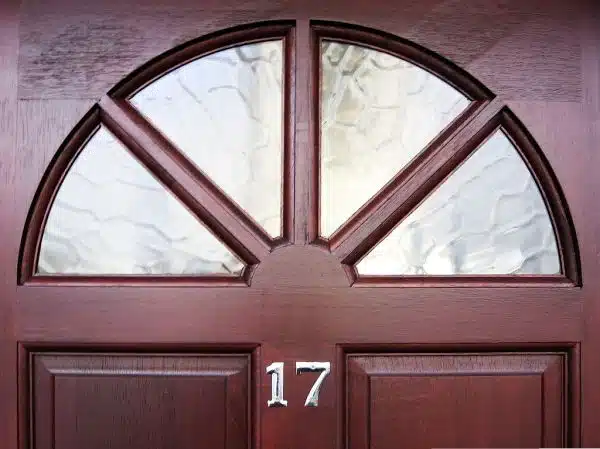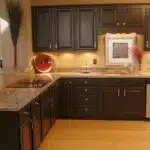As a professional painter or home improvement expert, painting a front door is an essential task that requires proper planning and execution. A well-painted front door not only enhances the overall curb appeal of a home but also provides protection against weather elements. However, painting a front door can be a daunting task for homeowners who lack the required skills and knowledge.
In this article, we will provide step-by-step instructions on how to paint a front door like a pro. From selecting the right paint to prepping the surface and applying the finishing touches, we will cover all aspects of the process in detail. Whether you are looking to refresh your home’s exterior or add a pop of color to your entryway, this guide will equip you with everything you need to know to achieve professional-looking results. So let’s dive in and learn how to transform your front door into a showstopper that will leave your neighbors envious!
Assessing Your Front Door’s Condition
As a professional painter or home improvement expert, you might already be aware of the importance of having a well-maintained front door. A freshly painted front door not only enhances your home’s curb appeal but also serves as a protective layer against weather elements. Before starting with the painting process, it is crucial to evaluate the wear and tear on your front door to find solutions that will ensure long-lasting results.
Begin by examining your front door’s overall condition. Check for cracks, dents, chips, and other damages that may require repair before painting. If you have an old wooden door that has started to rot, consider replacing or repairing it before proceeding with the paint job. In some cases, sanding and filling can fix small damages like scratches or minor dents.
Next, assess the type of paint currently on your front door. If it is chipping or peeling off in certain areas, you may need to remove it entirely before applying a new coat of paint. Make sure to use proper tools and techniques while removing old paint to avoid damaging the underlying surface. Evaluating wear and tear before painting will help you determine the necessary steps required for achieving excellent results in the end.
By now, you have assessed your front door’s condition and found solutions that will ensure optimal results after painting. The next step is choosing the right paint type that suits your needs and preferences.
Choosing The Right Paint Type
Assessing your front door’s condition is a crucial step to ensure that your painting project will result in an aesthetically pleasing and long-lasting finish. After you have determined that your front door is ready for a new coat of paint, it’s time to move on to choosing the right paint type. This section will guide you through the differences between oil and latex paint, as well as the various paint finish options.
Paint Finish Options Before you start painting your front door, it’s essential to choose the right paint finish. Here are three popular options:
High Gloss: This type of finish is shiny and reflective, making it an excellent choice for front doors that receive ample natural light. It’s also durable and easy to clean.
Semi-Gloss: A slightly less shiny option than high gloss, semi-gloss is still reflective and durable but doesn’t show imperfections as much.
Satin: Satin finishes have a low sheen, making them ideal for those who want an elegant look without too much shine.
Differences Between Oil and Latex Paint Oil-based paints were once the standard for exterior doors due to their durability and water-resistant properties. However, they can be challenging to work with due to their strong odor, long drying time, and the need for mineral spirits or turpentine for cleanup. On the other hand, latex paint has become increasingly popular over recent years due to its ease of use, quick drying time, low odor, easy cleanup with soap and water, and availability in many colors.
In summary, selecting the perfect color for your home is just one part of painting a front door. Before you dive into color swatches, assess your door’s condition thoroughly. Once you’ve done that, consider which paint type – oil or latex – would work best based on your preferences and skill level. Finally, choose a finish that complements both the style of your home and your personal taste. With these factors in mind, you’ll be on your way to a beautiful and long-lasting front door.
Selecting The Perfect Color For Your Home
Imagine walking into a beautifully decorated room. The furniture, lighting, and decor all complement each other in perfect harmony. But take a closer look, and you’ll see that the colors used in the room play an essential role in creating the atmosphere. Colors evoke emotions and feelings that can either enhance or detract from your overall experience. Color psychology plays a huge role in choosing the right color for your front door.
When selecting the perfect color for your front door, it’s important to consider not only the color of your home’s exterior but also its overall design. You want to choose a color that will coordinate with your exterior decor, enhancing its aesthetic appeal. For example, if you have a traditional style home with brick accents, you may want to choose a classic red or black door. If you have a modern home with clean lines and minimalistic features, you may opt for a bold color like bright blue or green.
Color psychology is also an important factor to consider when choosing the perfect color for your front door. Red symbolizes warmth and welcome; blue conveys calmness and serenity; green represents growth and renewal. These are just some of the emotions that certain colors can evoke in people. By choosing a color that aligns with your desired emotional response, you can create an inviting atmosphere before guests even step foot inside your home.
As you can see, there’s more to selecting the perfect color for your front door than simply choosing one that looks good with your house’s paint job. Coordinating with exterior decor while considering color psychology will help ensure that your choice not only looks great but leaves a lasting impression on guests as well. With this knowledge in mind, let’s move onto gathering the necessary materials and tools for painting your front door.
Gathering The Necessary Materials And Tools
Having chosen the perfect color for your front door, it’s time to gather all the necessary materials and tools before starting the painting process. Make sure you have all the supplies ready to avoid any unnecessary trips to the store. You’ll need a paintbrush, roller, sandpaper, primer, paint, painter’s tape, drop cloths, and cleaning supplies.
Before beginning the painting process, it’s essential to take proper safety precautions. Wear protective gear such as gloves and safety glasses to prevent any injuries. Cover floors and nearby objects with drop cloths to protect them from accidental spills or drips. Ensure that your workspace is well-ventilated by opening windows or using a fan.
When it comes to painting techniques for your front door, start by removing the door hardware such as handles and locks before starting the actual painting process. This step will make it easier for you to paint around these areas without getting paint on them. Afterward, clean your front door thoroughly with soap and water then use sandpaper to roughen up its surface. Finally, apply primer before painting your desired color for a smooth finish.
Removing The Door Hardware
Proper preparation is key when painting a front door. One important step is removing the door hardware, which includes hinges, handles, and locks. Tips for removing hardware include using a screwdriver or drill with appropriate attachments and taking caution not to strip screws or damage the surrounding wood.
Common mistakes during hardware removal include using the wrong size tool or forcing the hardware off without properly loosening screws. This can result in damage to the hardware or the door itself. It’s important to take your time and use proper techniques to ensure that all hardware is removed safely and efficiently.
Once all hardware is removed, you can move on to cleaning and sanding the door. But before doing so, it’s essential to label each piece of hardware and keep them in a safe place for easy reinstallation later on. With proper care during this step of the process, you’ll be one step closer to achieving a beautiful finish on your front door.
Cleaning And Sanding The Door
- Before painting a door, it is important to thoroughly clean the surface and remove any dirt, dust, and debris.
- Sanding is necessary to create a smooth surface and to help the paint adhere to the door properly.
- Abrasive cleaning pads and degreasers can be used to remove dirt and grease before sanding.
- Sandpaper of varying grits can be used to create a smooth surface, beginning with a coarse grit and finishing with a fine grit.
Cleaning Door
A front door is the first element that visitors notice about a home, and it’s essential to keep it clean to maintain its appeal. Cleaning the door is the first step in painting it, and it involves removing grime and dirt that may have accumulated over time. You can use a mild detergent or soap solution to remove dirt from the surface of the door. Alternatively, you can use a cleaning agent specifically designed for doors. Avoid using abrasive materials or harsh chemicals as they may damage the door’s finish.
Once you’ve removed all grime and dirt from your front door, it’s crucial to take measures to prevent future damage. Regular cleaning can help maintain your door’s luster and prevent dirt buildup. Additionally, applying a coat of sealant after cleaning will protect your door from weather elements such as rain and sun rays. It will also make subsequent cleaning more manageable since dirt won’t adhere easily.
Cleaning your front door regularly not only maintains its appearance but also prevents further damage, saving you money in repairs or replacement costs. With these simple steps, you can keep your front door looking new for years to come. Remember always to use gentle detergents and avoid harsh chemicals that can cause irreversible damage to your front door’s finish.
Sanding Door
Cleaning your front door is an essential part of maintaining its appearance and extending its lifespan. However, sometimes cleaning alone is not enough to restore an old or worn-out door. In such cases, sanding the door may be necessary to remove layers of paint or other damage that cannot be cleaned off. Using sandpaper and various sanding tools, one can achieve a smooth and even surface that is perfect for painting or staining.
Sanding a door requires some techniques and preparation for both beginners and pros alike. Before starting, it’s crucial to choose the right grit size of sandpaper suitable for the job at hand. Sanding with too coarse grit can remove too much material, while too fine grit may not produce enough abrasion to smooth out rough patches or scratches. Furthermore, safety should always be a top priority when sanding a door. Always wear eye protection and respiratory masks when sanding to prevent inhaling dust particles.
Sanding mistakes are common among DIY enthusiasts who attempt to save money by doing the work themselves without proper training or knowledge. Common mistakes include using too much pressure while sanding, which can cause uneven surfaces or gouges in the wood. Another mistake is failing to prepare adequately before sanding, such as removing all hardware and masking off any areas you don’t want to get sanded accidentally. With these tips in mind, even beginners can achieve professional-looking results with their doors’ sanding prep.
Filling In Any Cracks Or Holes
Once you have cleaned and sanded your front door, the next step is to fill in any cracks or holes. Choosing the right filler is crucial to achieving a smooth finish on your front door. You can choose between spackling compound or wood filler, depending on the size of the gaps and cracks.
If there are only small cracks or nail holes, spackling compound is an excellent choice for filling them in. It dries quickly and can be sanded down to a smooth surface. However, if there are larger gaps or holes, wood filler is a better option as it bonds well with wood surfaces. When applying either type of filler, ensure that you follow manufacturer instructions carefully and apply only enough filler to fill in the gap.
Tips for smoothing out rough surfaces include using sandpaper of different grits while sanding down the filled areas. Start with coarse-grit sandpaper and gradually move towards finer grits until you achieve a smooth surface. Additionally, inspect filled areas carefully before priming or painting to make sure that they are flush with the surrounding surface. Take care not to overfill any cracks or holes because this will require more sanding later on which can be time-consuming.
To mask off the surrounding area before painting your front door, use painter’s tape to avoid getting paint on adjacent surfaces such as walls or windows. Apply tape around hardware such as handles and locks to protect them from paint splatters or drips. Using paper or drop cloths can also help protect floors from paint drips. With these steps completed correctly, you’ll be ready for the next stage of painting your front door – priming!
Masking Off The Surrounding Area
Achieving a crisp and clean paint job on your front door requires careful preparation. Before you start painting, it’s important to mask off the surrounding area to avoid getting paint on surfaces that should remain untouched. This step is crucial for achieving a professional-looking finish.
The importance of precision cannot be overstated when masking off the area around your front door. Use painter’s tape to protect any areas that may come into contact with the paint, such as the door frame or nearby windows. Take extra care when taping around any hardware or fixtures on the door, such as knobs or hinges. You may also want to consider using drop cloths or plastic sheeting to protect floors and other surfaces from accidental drips or spills.
Tips for avoiding paint bleed include applying the tape in short sections rather than trying to wrap it all the way around corners or edges at once. Use a putty knife to press down firmly along the edge of the tape and ensure it adheres tightly to the surface. When painting, use light coats and allow each coat to dry completely before applying additional layers. By taking these steps, you can achieve a beautifully painted front door without any unsightly bleed marks.
Transition: Now that you have successfully masked off the surrounding area, it’s time to move on to applying the first coat of paint.
Applying The First Coat Of Paint
After masking off the surrounding area, it’s time to apply the first coat of paint on your front door. But before doing so, you must consider a few things to ensure that the application will result in a smooth finish without drips and brush strokes. Here are some tips to help you achieve that professional-looking outcome:
- Use a high-quality brush or roller appropriate for the type of paint you’re using and the surface of your front door.
- Apply the paint evenly by brushing or rolling in one direction from top to bottom. Avoid going back over areas already painted as this may cause streaks and unevenness.
- If using a brush, use only the tip and avoid applying too much pressure on it. This will help prevent bristle marks and leave a smoother finish.
Choosing the right brush or roller for the job is crucial in achieving a smooth application. The type of brush or roller you’ll use will depend on several factors such as the type of paint you’re using, the material of your front door, and your preferred finish. Here are some guidelines:
- For water-based paints, use synthetic brushes or rollers with a medium nap.
- For oil-based paints, use natural bristle brushes or rollers with a shorter nap.
- For surfaces with tight crevices and corners, use an angled brush for better coverage.
Remember that allowing the paint to dry completely between coats is important in achieving excellent results. Rushing into applying another layer while the previous one is not yet dry can cause peeling and cracking. To achieve optimal drying time, follow manufacturer’s instructions found on the label of your chosen paint product.
Allowing The Paint To Dry
Once the first coat of paint has been applied to the front door, it is important to allow sufficient time for it to dry before applying a second coat. This will ensure that the finish is smooth and even, without any smudges or streaks. Depending on the type of paint used and the weather conditions, drying times can vary greatly, but typically range from 4-24 hours.
To speed up the drying process, there are a few tips that can be followed. Firstly, ensure that the area around the door is well ventilated. Open windows and doors to allow air flow through the room, or use fans to circulate air around the door. Secondly, avoid painting in high humidity or cold temperatures as this can prolong drying times. Thirdly, consider using a fast-drying paint specifically designed for doors and trim.
While waiting for the first coat of paint to dry, it is important to take extra care to avoid smudges and streaks. Best practices include leaving the door open slightly so that it doesn’t stick to its frame while drying, avoiding touching any freshly painted areas with fingers or clothing, and using painter’s tape on any hardware or glass panels to prevent accidental marks. By following these guidelines, you can achieve a professional-looking finish on your front door with minimal hassle.
Moving onto applying the second coat of paint…
Applying The Second Coat Of Paint
As you move forward with painting your front door, it is essential to apply the second coat of paint. This will ensure that the finished product looks professional and polished. To begin, wait until the first coat of paint has completely dried before applying the second coat. This will prevent any smudging or streaking that may occur if you try to apply a second layer too soon.
Tips for applying the second coat of paint include using long, even strokes and maintaining a consistent pressure throughout the application process. You want to avoid overworking the paint as this can create brush marks and uneven surfaces. Additionally, pay attention to any areas that may need extra coverage and be sure to apply additional paint as needed.
Drying time for the second coat will depend on several factors such as temperature and humidity levels. It is best to wait at least 24 hours before removing any masking tape or other protective coverings from around the door frame. This will allow ample time for the paint to dry and cure properly, ensuring a smooth finish with no accidental smudging or damage.
As you near completion of your front door painting project, it is important to remove any masking tape carefully and slowly. This will help to prevent any tearing or damage to the freshly painted surface. Using a sharp utility knife or painter’s tool can help with removing any stubborn sections of tape without causing any harm to your newly painted front door.
Removing The Masking Tape
Now that you have applied the second coat of paint, it’s time to move on to the next step in painting your front door. Before removing the masking tape, make sure that the paint is dry to touch. You can use a clean finger to check if it is tacky or not. If it leaves no mark, then you can proceed with removing the tape.
To remove the masking tape, peel it off slowly and carefully at a 45-degree angle. This will prevent any damage to the newly painted surface. Make sure that you remove all the tapes without leaving behind any residue. If there are any stubborn bits left behind, you can use a scraper or sandpaper to remove them gently.
Alternative methods for removing masking tape include using a hairdryer or heat gun to warm up the adhesive before peeling it off. Another method is applying rubbing alcohol on the edges of the tape before peeling it off. Common mistakes when removing masking tape include pulling it off too quickly and at an incorrect angle which may result in peeling off some paint along with it.
With masking tape removed, your freshly painted front door looks amazing! Now, let’s move on to reinstalling the door hardware for a complete makeover.
Reinstalling The Door Hardware
Before we dive into reinstalling the door hardware, did you know that according to a study conducted by Zillow, painting your front door a bold color can increase the value of your home by up to $6,000? That’s right – a simple coat of paint can make a big difference.
Now, onto the task at hand. Proper alignment is crucial when reinstalling door hardware. Make sure all screws and bolts are tightened securely and in the correct location. Use a level to ensure that everything is straight and even. A misaligned lock or handle not only looks unprofessional but can also affect how well it functions.
Another important step to take when reinstalling door hardware is lubricating hinges. This will prevent squeaking and ensure smooth operation of the door. Apply a small amount of lubricant to each hinge and move the door back and forth to distribute it evenly. Not only will this make your door quieter, but it will also extend the life of your hinges.
With the door hardware properly installed and functioning smoothly, it’s time to add some finishing touches! Stay tuned for our next section on how to add those final details that will really make your front door stand out.
Adding Finishing Touches
After painting your front door, it’s time to add those finishing touches that will make it look even better. Adding decorative elements can breathe new life into your entryway and make your home stand out from the rest. Consider adding a wreath to the door, which can be easily changed out seasonally or for different holidays. Another great option is to add house numbers or a welcome sign. This not only adds visual interest, but also makes it easier for guests to find your home.
Choosing the right door handle is an important decision when adding those finishing touches. The handle should complement the style and color of your newly painted door, as well as provide functionality and security. A popular choice is a sleek and modern handle in a contrasting color to the door. However, if you have a more traditional style home, consider a classic brass or bronze handle with intricate details.
Overall, adding those finishing touches can take your front door from ordinary to extraordinary. Remember to choose decorative elements that complement the style of your home and paint job, and select a functional yet stylish door handle that provides security while still being visually appealing.
As you admire your newly painted and decorated front door, it’s important to keep in mind how to maintain its beauty for years to come. Proper maintenance will ensure that the paint job stays fresh and vibrant for as long as possible. In the next section, we will discuss tips on how to care for and maintain your newly painted front door.
Maintaining Your Newly Painted Front Door
After painting your front door, it’s essential to maintain its appearance and longevity. A freshly painted door can add curb appeal to your home, but if it’s poorly maintained, the paint can fade quickly or become scratched. To prevent fading and avoid scratches, there are some steps you can take.
Firstly, ensure that your newly painted front door is completely dry before touching it. It’s best to wait at least 24 hours after painting before attempting any maintenance. Once dry, use a gentle soap and water solution with a soft-bristled brush to clean the door. Avoid using harsh chemicals or abrasive sponges as these can damage the paintwork.
Secondly, be mindful of direct sunlight on your door. If your front door receives high levels of sunlight throughout the day, it may be prone to fading over time. To prevent this, consider installing a porch awning or invest in a UV-resistant clear coat for added protection.
Lastly, avoid slamming the door shut or allowing heavy objects to come into contact with it. These actions can cause scratches and chips in the paintwork. Instead, close the door gently and use a doormat to catch any debris that could cause damage.
Preventing Fading:
- Ensure that your front door is not subjected to direct sunlight
- Install a porch awning or invest in a UV-resistant clear coat
- Regularly clean and maintain your front door
Avoiding Scratches:
- Close the door gently
- Use a doormat to catch debris
- Avoid slamming the door shut or allowing heavy objects near it
By following these simple steps, you can ensure that your newly painted front door remains in pristine condition for years to come. Not only will this enhance the appearance of your home but also add value when you come to sell. Remember that regular maintenance is key to keeping any painted surface looking its best!
Conclusion
When it comes to painting your front door, there are several steps you can take to ensure a successful project. First, assess the condition of your door and choose the right paint type for the material. Then, select a color that complements your home’s exterior. Gather all necessary materials and tools before removing the door hardware and masking tape.
Once you’ve painted your door, reinstall the hardware and add any finishing touches. Remember to maintain your newly painted front door by regularly cleaning it and touching up any chips or scratches. While some may argue that professional painters should handle this task, with the right preparation and attention to detail, anyone can transform their front entrance in just a few simple steps. So go ahead, give your home’s curb appeal a boost with a freshly painted front door!
Image Credits
- “Front Door” by Cristiano Betta (featured)





























